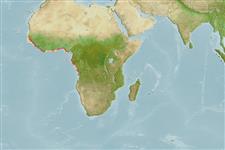Preferred temperature (Ref.
123201): 23.4 - 27.9, mean 26.5 °C (based on 64 cells).
Phylogenetic diversity index (Ref.
82804): PD
50 = 0.5020 [Uniqueness, from 0.5 = low to 2.0 = high].
Bayesian length-weight: a=0.00646 (0.00309 - 0.01347), b=3.05 (2.86 - 3.24), in cm total length, based on LWR estimates for this species & (Sub)family-body (Ref.
93245).
Nivel trófico (Ref.
69278): 4.0 ±0.7 se; based on size and trophs of closest relatives
Resiliencia (Ref.
120179): Alto, población duplicada en un tiempo mínimo inferior a 15 meses (Preliminary K or Fecundity.).
Fishing Vulnerability (Ref.
59153): Low vulnerability (16 of 100).
Nutrients (Ref.
124155): Calcium = 224 [121, 457] mg/100g; Iron = 1.05 [0.57, 1.89] mg/100g; Protein = 17.7 [16.0, 19.3] %; Omega3 = 0.149 [0.079, 0.267] g/100g; Selenium = 35.2 [18.0, 71.9] μg/100g; VitaminA = 27.5 [9.8, 66.8] μg/100g; Zinc = 1.84 [1.27, 2.67] mg/100g (wet weight);
